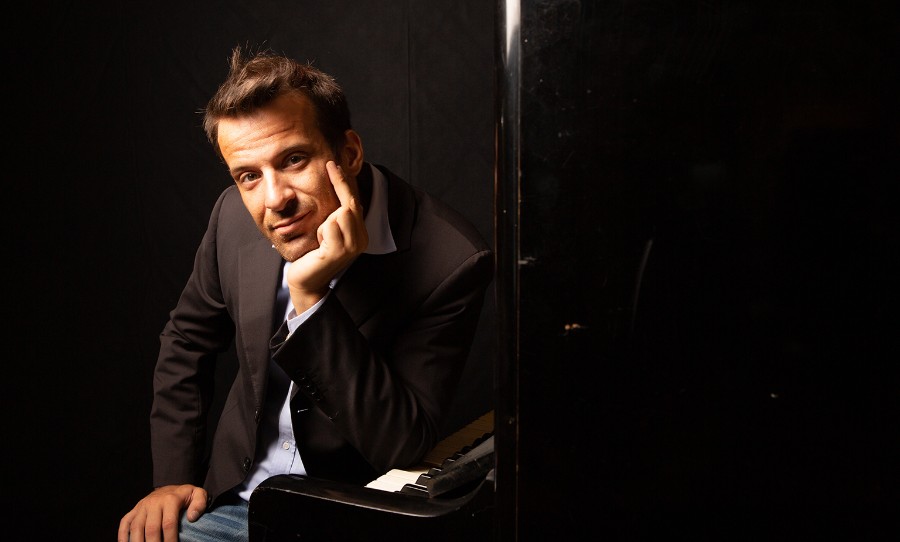If you were to name 5 composers who changed the path of music or realised music’s potential, Karlheinz Stockhausen would be one of them. He is considered one of the most important figures of 20th-century avant-garde music.
His innovation, experimentation and exploration of sound’s potential in a compositional framework mark him as a standalone visionary. Stockhausen’s enigmatic career didn’t come without the controversy however, as his interpretation of art was driven by extreme and eclectic views in the succession of modernism.
A pioneer of electronic music and experimentation, Karlheinz Stockhausen is revered by many in his exploration of realising the full potential of musical composition.
Early life, Germany during WWII
As with many great artists, an introduction to their early life paves an explanatory path to their musical intuitions and ideas. However, with Stockhausen; the explanation of his upbringing is somewhat of a necessity to understand his later works.
Stockhausen began playing the piano at age 7 and by the age of 14 had begun lessons in oboe and violin where he had relocated cities. He began studying at a boarding school after his father remarried and got word that his mother had passed away in 1941 after being institutionalised for having a nervous breakdown.
Years later it was revealed that his mother was a victim of the Nazi regime and had been gassed in an early Nazi experiment, which would later be put to wider uses.
As Stockhausen progressed in his musical career, the death of his mother and the Nazi regime in his homeland of Germany had a large impact on the way he would perceive and in turn, create music. He was in turn, haunted by 4/4 time signatures as they reminded him of Nazi marches. He would endeavour to stay as far away from the rigidity and form of this musical attribute for the remainder of his career.
Exploration and intuition
He was a visionary for the potential of what possibilities music had still yet to uncover and lay the groundwork for avant-garde approaches to music-making.
Stockhausen’s music is about finding the answers or searching for meaning both within one’s self and within the universe. There is a sense of chaos, intrigue, organic complexity and enlightenment in all of his works. These unconventional intuitions are a result of his depth of knowledge and intrigue in the way the world works.
Karlheinz Stockhausen studied musical pedagogy, philosophy, germanics, phonetics, acoustics, information theory and compositional aesthetics and analysis. All of these educational ventures play an important role in shaping the way that Stockhausen transposed his knowledge and ideas into a musical framework.
With a fascination for chance decisions of will and intuition, Stockhausen allows performers a choice between several sequences. In his mind, each one is just as good as the other but it is for the performer to explore their potential and choose their path.
Electronic transformations
Visionary exploration and musical experimentation were at the forefront of Stockhausen’s agenda. He wanted to communicate the complexity of sound and the alternate angles that could be used to realise its potential.
These electronic works explore the capabilities of synthesis and sound, yet are still set in a distinct form. Telemusik is Stockhausen’s 20th categorised work and was commissioned by the Japanese broadcasting system Nippo Hoso Kyokai in 1966. He said this of the composition:
“the chant of monks in a Japanese temple with Shipibo music from the Amazon, and then further imposing a rhythm of Hungarian music on the melody of the monks. In this way, symbiotic things can be generated, which have never before been heard.”
Telemusik consists of 32 structures called ‘moments’ each beginning with the strike of a traditional Japanese temple instrument. Each instrument is associated with a moment duration according to the instrument’s natural decay time. The duration in seconds is each taken from the six Fibonacci numbers between 13 and 144.
These electronic explorations were an extreme step forward for alternate compositional approaches. Karlheinz Stockhausen was fascinated with not only musical explorations and new compositional frameworks. He had a desire to explore sound as a medium in itself.
Take Mikrophonie 1 for example. In this composition, Stockhausen utilizes the microphone in the way that it interacts with the characteristics and dynamics of a tam-tam, which were struck by different implements such as glass, cardboard, metal, wood and plastic.
In the Journal of New Music Music Research, Christpoher Burns writes:
“In Mikrophonie I two percussionists play a large tam-tam with a variety of implements. Another pair of players use hand-held microphones to amplify subtle details and noises, inflecting the sound through quick (and precisely scored) motions. The last two performers, seated in the audience, apply resonant bandpass filters to the microphone outputs and distribute the resulting sounds to a quadraphonic speaker system.”
Spatialisation, harmonics and controlled chance
Stockhausen utilised the technique of spatialisation and many of his works throughout his career. Spatialisation refers to the primary source of sound being an integral part of the composition for the audience.
This technique was often paired with aleatoric music, which refers to music where one or more elements of the composition are left to chance.
Stimmung utilises all of these techniques and is considered the first major western composition to be based entirely on the production of vocal harmonics. This piece is composed for six vocalists and six microphones.
The concept was conceived while Stockhausen was walking through ruins in Mexico and wanted to recreate that same environment in a musical context.
Helicopters, operas & the cosmic spirit
A composition that took modern techniques to new heights, Stockhausen’s Helikopter-Streichquartett is one of his best-known works and one which exhibits Stockhausen’s spatialisation techniques working to their fullest potential. The piece features 4 violinists, 4 helicopters with pilots as well as audio and visual equipment.
Whilst he will be forever considered a maverick in his art, there are many who question his exploratory approach to new ideas. This is largely due to the way he came across as elitist with his esotericism and disregard for traditional form, holding a deep desire for the required alteration and progression of music’s place in history.
Then there is the part where he dreamt of coming from planet Sirius, where “everything is music, or the art of co-ordination and harmony of vibrations. . . . The art is very highly developed there, and every composition on Sirius is related to the rhythms of nature . . . the seasons, the rhythms of the stars.”
This esotericism was turned into a piece titled Sirius, which was an 8-channel composition for electronics, trumpet, soprano, bass clarinet and bass.
This composition sent Stockhausen running in the direction of music-theatre.
His next step after these new found cosmic revelations was to start on what would turn out to be a 29 hour, 7 cycle opera called Licht, which he described as an ‘eternal spirit’.
Legacy
The Beatles, David Bowie, Frank Zappa, The Grateful Dead, Björk and Kraftwerk are just a few of the biggest names in music’s history who site Karlheinz Stockhausen as an influence. The BBC has awarded him the title of Papa Techno due to his transformative and exploratory approach to composing with electronics.
See Stockhausen featured in this close-up of The Beatles album artwork for Sgt. Peppers Lonely Hearts Club Band in the top row fifth from the left. 
Stockhausen’s approach to composition is closely aligned to the way an engineer approaches a mix: alongside raw musical materials, elements of space, dynamic and timbre play pivotal roles. Unlike the digitally controlled electronics that we take for granted in contemporary workflows, Stockhausen’s ‘mixing’ was analog and had to be controlled and manipulated in physical space, in real-time and was subject to chance. In this respect, perhaps it was his daring approach and commitment that made him an inspiration to such a broad spectrum of musicians.


